Board in the Library, Part the Third
Thematic vs Strategic Games
We are pleased to publish this article, the third in a six-part series on board game programming in public libraries, from John Pappas, the Branch Manager at the Bensalem Branch of the Bucks County Free Library System. (Read Part One | Part Two | Part Three | Part Four | Part Five | Part Six) See also webinars with John on boardgames: The Golden Age of Gaming: Board Games for Grown-ups and Whose Turn Is It, Anyway? Online Board Gaming and Libraries.
Introduction
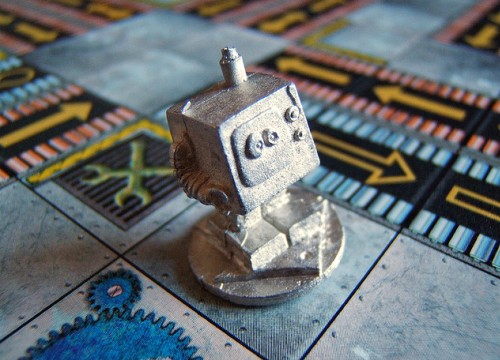 Welcome to the world of modern board games! Upon entering you will be bombarded with two terms: Thematic and Strategic games. Sometimes they will also be referred to as "Ameri-trash" vs. "Euro-games." For the new gamer or the librarian just entering this wonderful world, it may be easy to assume that the world of modern board games is a binary one, with thematic games on one end and strategic games on the other and then a linear progression lying between. However, a healthier way of viewing it is as two styles with a varying amount of overlap and plenty of subjective criteria applied to each. So when you enter this world, remember these terms are very loosely applied and perhaps are not as important as other considerations (such as how the game plays, the interaction it encourages, and how much fun people have playing). But you are going to hear the terms, so let's talk about them.
Welcome to the world of modern board games! Upon entering you will be bombarded with two terms: Thematic and Strategic games. Sometimes they will also be referred to as "Ameri-trash" vs. "Euro-games." For the new gamer or the librarian just entering this wonderful world, it may be easy to assume that the world of modern board games is a binary one, with thematic games on one end and strategic games on the other and then a linear progression lying between. However, a healthier way of viewing it is as two styles with a varying amount of overlap and plenty of subjective criteria applied to each. So when you enter this world, remember these terms are very loosely applied and perhaps are not as important as other considerations (such as how the game plays, the interaction it encourages, and how much fun people have playing). But you are going to hear the terms, so let's talk about them.
Let's talk about thematic and strategic games: what they are, what defines each, and how some overlap exists. You need to understand where and how these types of games interact; that interaction will help you determine what type of players your patrons tend to be; what type of games they may prefer and how to provide them with options that will leave them happy, satisfied and coming back for more. The following descriptions are not chiseled in stone and will likely change and develop into a personal view of gaming as you play more games, teach more games, and experience more people playing games.
Thematic Games
 Also known as “Ameri-trash” games due to a predilection of many American board game publishers to produce highly immersive and narrative-based games. However, the provenance of these games are not from a particular region or country. Usually the term “thematic” is preferred for that reason, and due to the derogatory connotation of the term “trash.” Personally, I prefer to describe these games in terms of narrative potential. Does the gameplay (how the game plays and the mechanisms of the game) create, develop or maintain an ongoing story? Is it a story with atmosphere, action, conflict, and characterization? A good thematic game will develop a story arc that will be remembered, discussed and embellished long after the game ends.
Also known as “Ameri-trash” games due to a predilection of many American board game publishers to produce highly immersive and narrative-based games. However, the provenance of these games are not from a particular region or country. Usually the term “thematic” is preferred for that reason, and due to the derogatory connotation of the term “trash.” Personally, I prefer to describe these games in terms of narrative potential. Does the gameplay (how the game plays and the mechanisms of the game) create, develop or maintain an ongoing story? Is it a story with atmosphere, action, conflict, and characterization? A good thematic game will develop a story arc that will be remembered, discussed and embellished long after the game ends.
(Note: These shouldn’t be confused with storytelling games where the core mechanism of the game is to create a narrative or story. While these games are generally thematic, the storytelling mechanic is not mandatory for a thematic game. Remember it is the narrative potential of a game that make it thematic and that potential is realized by the people playing it.)
Thematic games may focus on one of several tropes that are very common in board games or within the realm of larger geek culture. Space and other science fiction themes, zombies or post-apocalyptic scenarios, fantasy (dragons, elves, dwarves and their ilk) are all very common themes. While it is not guaranteed that these themes will necessarily be included in a thematic game, it is very likely that if a box cover features hordes of zombies rushing over a barricade, a bunch of space ships shooting at each other, or a group of intrepid adventures delving into the dark dungeons of the deep, then the game is thematic. Basically, if the box cover looks like a blockbuster action movie then you potentially have a very thematic game.
Thematic Games, Immersion and Rules
 Thematic games tend to value immersion above all else. This immersion comes first and then the mechanisms of the game are developed in a “top-down” manner. Each mechanism is added to the game, then tweaked and refined in order to generate a feeling of immersion into the premise of the game. For example, in Space Alert, players are given short, hectic missions to accomplish (battling spaceships, escaping aliens, computer malfunctions). While this seems simple, the inclusion of an added soundtrack, intense player interaction, and a rushed ten minute time limit provide plenty of narrative fodder as players work to coordinate their actions in a real-time environment usually at the top of their lungs. The game emotes a theme of tense action, quick-thinking, and a harried sense of panic. The difficulty is that when attempting to capture a feeling or sense of urgency (or realism, adventure, etc.), these game mechanisms tend to be stacked onto each other leading to complex games with large sets of rules. Each rule helps invoke an increased amount of immersion and realism into the game. As with many of the generalizations made in this article, it does not necessarily hold true and some games can be extraordinarily deep in theme while remaining shockingly simple in mechanism and rules.
Thematic games tend to value immersion above all else. This immersion comes first and then the mechanisms of the game are developed in a “top-down” manner. Each mechanism is added to the game, then tweaked and refined in order to generate a feeling of immersion into the premise of the game. For example, in Space Alert, players are given short, hectic missions to accomplish (battling spaceships, escaping aliens, computer malfunctions). While this seems simple, the inclusion of an added soundtrack, intense player interaction, and a rushed ten minute time limit provide plenty of narrative fodder as players work to coordinate their actions in a real-time environment usually at the top of their lungs. The game emotes a theme of tense action, quick-thinking, and a harried sense of panic. The difficulty is that when attempting to capture a feeling or sense of urgency (or realism, adventure, etc.), these game mechanisms tend to be stacked onto each other leading to complex games with large sets of rules. Each rule helps invoke an increased amount of immersion and realism into the game. As with many of the generalizations made in this article, it does not necessarily hold true and some games can be extraordinarily deep in theme while remaining shockingly simple in mechanism and rules.
Two good examples of games being highly thematic but with a reduced ruleset are two of my favorites: Letters from Whitechapel from Fantasy Flight Games, and Going, Going, Gone from Stronghold Games (designed by the Grand Poobah of gamification, Scott Nicholson). Each of these games have very simple rules and produce the feel of their theme very well. In Letters from Whitechapel, the theme of hunting Jack the Ripper through Victorian England comes off flawlessly, with Jack moving around hidden on the board with the investigators (most of the players) searching for him. At the same time, the player taking the role of Jack feels all of the tension and stress of knowing how close [s]he is to being captured. It is an extremely tense and thematic experience with nearly every game ending in a debriefing session of stories of how close to capture Jack was.
In Going, Going, Gone, the chaos and excitement of an actual auction comes to life with each player attempting to bid on items by frantically dropping cubes into different containers to bid on specific items while the auctioneer counts down (at his own preferred pace) to the end of the bidding cycle. Unlike Letters from Whitechapel not much of a story arises from playing Going, Going, Gone. However, players feel as if they are really immersed in an auction.
The bottom line is that thematic games tend to be typified by long and complex rules. However, games with simple rules and few mechanics can still be extraordinarily immersive and thematic.
Thematic Games, Conflict, and Player Interaction
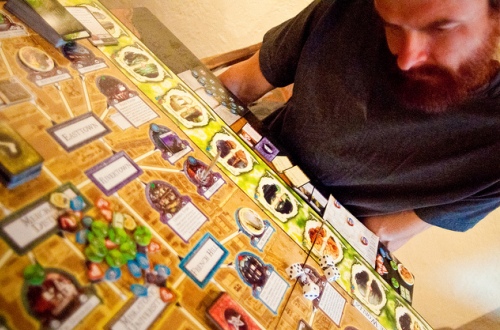 We will discuss player interaction at length in my next post (it is, by far, my favorite topic) but here I’d like to introduce the concept of “direct conflict.” This interaction, encouraged in many thematic games, centers around combat or competition and unlike many strategic or Eurogames, it is directed fully at other players. Again, I am going to backpedal and mention that many thematic games are cooperative in nature such as the previously mentioned Space Alert. But also look at the popular Arkham Horror (or the newly released Eldritch Horror) games from Fantasy Flight Games. In these games the players work cooperatively to battle H.P. Lovecraft’s Great Old Ones. In some of these cooperative or competitive scenarios, players will roll dice, draw and resolve cards, and move around a map or game board accomplishing goals. Everything is story-driven and a narrative arises from these actions. Similar to real life, luck and serendipity play a huge role in how these situations resolve, so players are never completely in control. You may spend a game carefully planning out moves and strategies only to be foiled in the end by a series of maddeningly horrible card draws or hideously unfortunate dice rolls -- bad luck! Ask yourself (and consider the question for your patrons): do you/they wish to be in control of everything that happens in a game? If the answer is “yes” then a richly thematic game chock full of luck, dice, and cards may not be your first choice.
We will discuss player interaction at length in my next post (it is, by far, my favorite topic) but here I’d like to introduce the concept of “direct conflict.” This interaction, encouraged in many thematic games, centers around combat or competition and unlike many strategic or Eurogames, it is directed fully at other players. Again, I am going to backpedal and mention that many thematic games are cooperative in nature such as the previously mentioned Space Alert. But also look at the popular Arkham Horror (or the newly released Eldritch Horror) games from Fantasy Flight Games. In these games the players work cooperatively to battle H.P. Lovecraft’s Great Old Ones. In some of these cooperative or competitive scenarios, players will roll dice, draw and resolve cards, and move around a map or game board accomplishing goals. Everything is story-driven and a narrative arises from these actions. Similar to real life, luck and serendipity play a huge role in how these situations resolve, so players are never completely in control. You may spend a game carefully planning out moves and strategies only to be foiled in the end by a series of maddeningly horrible card draws or hideously unfortunate dice rolls -- bad luck! Ask yourself (and consider the question for your patrons): do you/they wish to be in control of everything that happens in a game? If the answer is “yes” then a richly thematic game chock full of luck, dice, and cards may not be your first choice.
Another delightful element of many thematic games is something called “asymmetrical play.” This means that part of the game allows you to choose characters (like the specialists in the firefighting game Flash Point Fire Rescue), different alien races (as in the classic Cosmic Encounters) or nations (as in another American thematic classic Fortress America). Each of these factions end up having some unique abilities or special powers that make them different from the other characters. This makes the gameplay varied and sometimes it can make certain factions or characters more difficult to play. An uneven playing field can be frustrating to some but it also adds a lot to the story element of the game by adding richness of characterization and depth to otherwise two-dimensional tokens and chits. In a word, it adds flavor.
Speaking of flavor, thematic games add additional “fluff” text to increase the narrative experience. Think of the old saying “Where there’s fat, there’s flavor” and change it to “Where there’s fluff, there’s flavor.” The text might include more detailed bits and pieces of narrative to help the story along or provide players with a gentle nudge in the correct imaginative direction. Additionally, thematic games may also include components such as plastic miniatures (think little green army men) that help connect the players to the game. As an example compare 1775: Rebellion, an amazing war/Euro game, to Kemet, a similarly simple war game but with a massive infusion of components. In 1775, armies are represented by different colored cubes. In Kemet, you have plastic figures shaped to represent the different Egyptian forces, giant scarabs, and even a war-elephant! I think Kemet takes the cake with telling a story through components.
Summing Up Thematic Games
Thematic games are usually:
- more complicated when compared to other games;
- focus more on direct conflict (with some cooperation);
- will feature popular “geeky” topics and tropes;
- are more luck-based with lots of dice and cards;
- tell a story or provide a rich narrative experience;
- are more tactical than strategic, and;
- can potentially play longer than other games.
Some classic thematic games: (parentheses include games that play faster with easier rules)
- Last Night on Earth (or Dead Panic)
- Battlestar Galactica (or Space Alert)
- Cosmic Encounter
- Flash Point: Fire Rescue
- Castle Panic
- Eldritch Horror (or Elder Sign)
- Shadows over Camelot (or The Resistance: Avalon)
- Betrayal at House on the Hill
- Mice and Mystics
- Tales of the Arabian Nights (Or Once Upon a Time)
- Bootleggers
Strategic Games
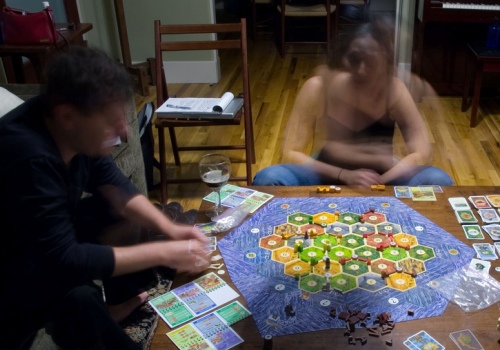 On the other side of our imaginary coin are strategic games, which are sometimes also referred to as Eurogames. This is another descriptor that related originally to provenance, with many engaging strategic games coming out of Europe (especially Germany). These days, though, many similar games come from all around the world. At this point you are probably already familiar with one of the most well-known Eurogames, The Settlers of Catan. When this game came out in 1995, it quickly gained a following and grew in popularity, and now it is practically ubiquitous (as far as modern board games go) and can be picked up at Target, Barnes & Noble, and, frankly, is probably on your grandma’s closet shelf next to Parcheesi.
On the other side of our imaginary coin are strategic games, which are sometimes also referred to as Eurogames. This is another descriptor that related originally to provenance, with many engaging strategic games coming out of Europe (especially Germany). These days, though, many similar games come from all around the world. At this point you are probably already familiar with one of the most well-known Eurogames, The Settlers of Catan. When this game came out in 1995, it quickly gained a following and grew in popularity, and now it is practically ubiquitous (as far as modern board games go) and can be picked up at Target, Barnes & Noble, and, frankly, is probably on your grandma’s closet shelf next to Parcheesi.
If thematic games provide a story or an unfolding narrative, then strategic games present a problem and then create a magnificent machine with well-crafted mechanisms and cogs that allow you to attempt to solve that problem. This type of game flows delightfully through phases until a winner is produced. These mechanisms are what give these games their mathy, “think-y”, strategic feel. They can be brain-burners and often provide a wide array of paths to gain victory, sometimes causing players to furrow their brows in concentration to find the best method to win. Others can be simpler and focus on gameplay. Let’s put this into perspective with the thematic games described above. In those games, the designer may have had a particular story or theme to present to the players. The designer likely started with that theme, setting, or premise, and then found mechanisms that helped employ the theme in the most narratively tight and immersive manner possible. In a strategic game the focus isn’t on the story generated; instead the focus is on innovative mechanics that make gameplay tight, smooth, and balanced. The theme, if any, is applied lightly on top.
Strategy, Control, and Zero-Luck
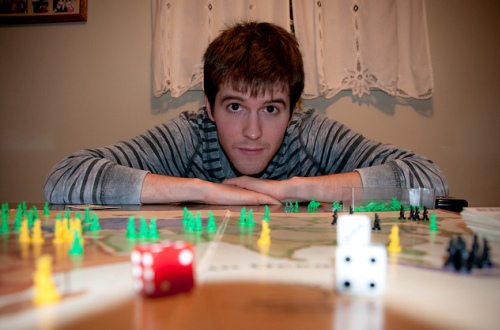 Unlike thematic games, the players of a strategic game generally want control. When playing this kind of game, they are creating a formula that will optimize the game’s mechanics in order to out-play another player and/or score as many points as possible. Mechanisms that randomize results such as dice or card draws are reduced in these games, and sometimes even eliminated completely. You may still find elements of luck in strategic games. I like to think along the lines of the popular saying “fat equals flavor” but change it to “luck equals fun.” As such, you will find elements of luck in a strategic game (as much as you would find elements of strategy in a thematic game), but in a strategic game the luck tends to be easily mitigated by increasing player choices and widening the amount of decisions possible so that a run of poor dice rolls would not negatively affect the strategy too much.
Unlike thematic games, the players of a strategic game generally want control. When playing this kind of game, they are creating a formula that will optimize the game’s mechanics in order to out-play another player and/or score as many points as possible. Mechanisms that randomize results such as dice or card draws are reduced in these games, and sometimes even eliminated completely. You may still find elements of luck in strategic games. I like to think along the lines of the popular saying “fat equals flavor” but change it to “luck equals fun.” As such, you will find elements of luck in a strategic game (as much as you would find elements of strategy in a thematic game), but in a strategic game the luck tends to be easily mitigated by increasing player choices and widening the amount of decisions possible so that a run of poor dice rolls would not negatively affect the strategy too much.
To be clear, it isn’t that strategic games don’t have theme. Many of the them do and are actually quite thematic, with tense moments and a wonderfully generated narrative. However, the topics of many of those themes tend to be dry. Popular themes for strategic games include economics, historical themes, trade and mercantile, travel and exploration, or vocations. High tempo, big emotion themes tend to be avoided. Themes that focus on efficiency, economics, and optimization are preferred. Since these themes are much drier, the focus is less on the experience of the theme and more on the implementation of the mechanisms which drive the game. This allows for better developed systems, simpler rules, and a better balanced game with every player starting from the same point. A wonderful example of a classic strategic game with a nice thematic feel is Agricola. In Agricola, players are medieval farmers, starting with very little and scraping to survive through proper management of fields, houses, and family members. The game’s theme is undeniably dry but the emotional impact of struggling to feed a family while building improvements and increasing land, holdings, and family can be quite strong.
Playing Nice and Wooden Cubes
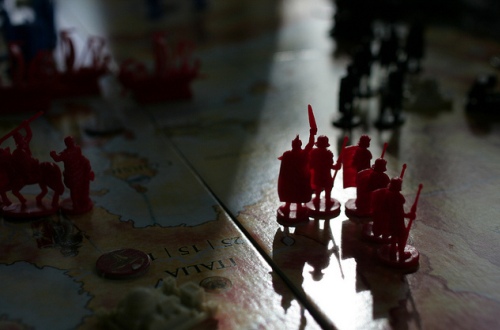 In strategic games the player interaction is much more refined and delicate when compared to many thematic games. Rather than direct conflict, players may compete for resources or better spaces on the board and, through those actions, deprive other players of those spaces or resources. In this way, players are being deprived of optimal player position rather than directly attacked or impeded. Compare this to thematic games where players may be actively attacking through combat or pursuing other players in order to eliminate or reduce the threat presented by them. Strategic games present a kinder and gentler player interaction when each player focuses on their own player board or tableau (playing something called “multiplayer solitaire”), with minimal confrontation between players. Here they are focusing on creating tableaus which create efficient machines to generate points; not trying to actively knock people out of the game. This can be a very introverted type of gaming: thinking and creating and silently working to an end-goal; and it can be very satisfying when a plan comes together nicely.
In strategic games the player interaction is much more refined and delicate when compared to many thematic games. Rather than direct conflict, players may compete for resources or better spaces on the board and, through those actions, deprive other players of those spaces or resources. In this way, players are being deprived of optimal player position rather than directly attacked or impeded. Compare this to thematic games where players may be actively attacking through combat or pursuing other players in order to eliminate or reduce the threat presented by them. Strategic games present a kinder and gentler player interaction when each player focuses on their own player board or tableau (playing something called “multiplayer solitaire”), with minimal confrontation between players. Here they are focusing on creating tableaus which create efficient machines to generate points; not trying to actively knock people out of the game. This can be a very introverted type of gaming: thinking and creating and silently working to an end-goal; and it can be very satisfying when a plan comes together nicely.
Let us discuss components and the mainstay of the modern strategic game: the wooden cube. In a variety of colors, the wooden cube can represent coal, wizards, trains, train stations, cars, vegetables, or anything else you need it to be. While arguably unimaginative, the components are not generally the focus of a strategic game; the focus is on how the game plays.
Besides, there is one delightful thing about the wooden cube: it is easily replaced when lost. Librarians love that!
Summing Up Strategic Games
Strategic games are usually:
- simpler with short rule sets;
- focus more on individual efficiency;
- will feature dry themes and topics;
- less luck and more advanced planning;
- provide a balanced game and thinking experience, and;
- are more strategic than tactical.
Some classic strategic games include:
Why This Matters
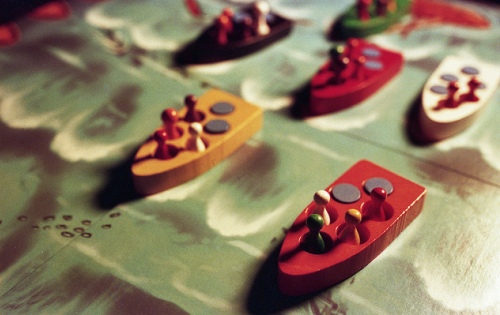 Understanding board games and the terms and concepts that go with them will help librarians connect with gamers, gaming groups, and board game publishers. The divisions themselves are artificial; many games include both strong thematic and strategic elements. Within that huge variety, and as board game designers become more innovative and creative, you will find titles that break all your fabricated molds. However, using these divisions will help you learn which type of games you and your patrons prefer, and can help you figure out what types of gamers your events tend to attract. It will help you develop a collection which will be broad enough to appeal to a large community while retaining a flavor that speaks to the general expectation of your gaming events.
Understanding board games and the terms and concepts that go with them will help librarians connect with gamers, gaming groups, and board game publishers. The divisions themselves are artificial; many games include both strong thematic and strategic elements. Within that huge variety, and as board game designers become more innovative and creative, you will find titles that break all your fabricated molds. However, using these divisions will help you learn which type of games you and your patrons prefer, and can help you figure out what types of gamers your events tend to attract. It will help you develop a collection which will be broad enough to appeal to a large community while retaining a flavor that speaks to the general expectation of your gaming events.
Knowing your preference can also make it easier to judge whether or not a game is worth the money, but you should never judge a game by whether it claims to be Euro or Ameritrash style. Both categories have great games; both have quality fans and die-hard defenders ; both, of course, also have their share of lunatics and shoddy products. Ultimately, you should play the games that you enjoy the most and just ignore what other people say you should and should not like.
 Next Up: Player Interaction
Next Up: Player Interaction
Continue on to the next article, where we delve into the world of player interaction! If you want to interact with me on all things library, board gaming, or the intersection of the two then you can find me on Twitter.
John Pappas is the Branch Manager at the Bensalem Branch of the Bucks County Free Library System. He enjoys talking about emerging technologies, gaming, public librarianship, outreach, and zen.
